 |
|
At left: St. Cuthbert's Way follows the story of a seventh-century saint who traveled through Britain, preaching and performing miracles. It begins in Melrose, the location of the Celtic monk's early monastic life, and end in Lindisfarne, often called "Holy Island," where he spent his later ministry.
Credit: Rev. C.J. Haywood
|
Sara Wenger Shenk has been president of Anabaptist Mennonite Biblical Seminary in Elkhart, Indiana, since 2010. She took a three-month sabbatical in 2015–16, but spread it out over December, February, and July. Each of the three months included approximately two weeks for writing and two weeks for a focused retreat and spiritual renewal — once at St. John’s Abbey Guesthouse in Collegeville, Minnesota; once at a condo in Florida; and once on a 62-mile walk along St. Cuthbert’s Way on the borderland between England and Scotland.
Wenger Shenk said the time away freed her to “breathe deeply, prayerfully, imaginatively, and synthetically.” She returned with a deeper well of generative ideas and renewed vision. She recommends that seminary presidents “speak boldly to their boards about how important sabbatical time is for enhancing the quality of their work and improving the chances of longevity in the position.”
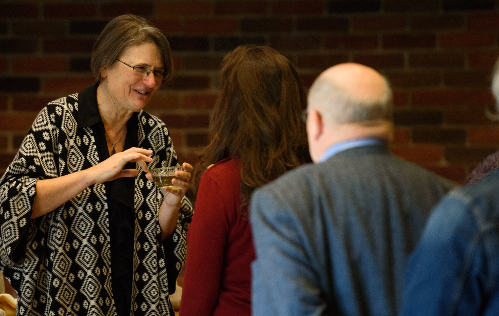 |
Sara Wenger Shenk (left) took a three-month sabbatical in 2015-16 but spread it over December, February, and July.
Credit: Jason Bryant |
A recent informal survey conducted by In Trust found that of the 92 seminary presidents and chief executives who replied, 24 percent had taken a sabbatical. Both those who had and those who hadn’t said that it was challenging to find the time to take the leave that they had been granted. And it was challenging to find someone to assume their duties on a short-term basis. In Trust followed up with telephone interviews with several presidents and found that they had worked with their boards to create a wide variety of arrangements.
A month per year
Lee Barker has been president of Meadville Lombard Theological School in Chicago since 2003. When he began discussing a sabbatical with the trustees a few years ago, he says that it didn’t seem practical. “At the time, we were so stressed about our future that it did not seem like a good idea for me to take extended time away.”
So they negotiated that he would take a month every year in February, with an additional sabbatical at the end of his employment at the school. “I have announced my retirement at the end of the 2018–19 academic year, and I will take a terminal sabbatical at that time,” Barker adds.
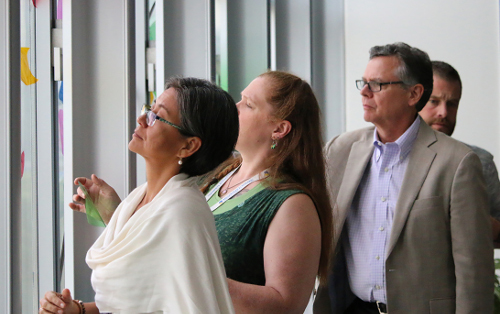 |
"I took a whole month and went to 22 museums, art exhibits, concerts, and lectures. That was probably the most renewing sabbatical I have ever had," says Lee Barker (third from left).
Credit: Tomo Hillbo |
He has been taking month-long leaves for the last seven years, and during those times he has worked on projects like revamping a course and developing international partnerships. “But the sabbatical I remember most fondly is when I decided not to travel anywhere,” he reflects. “I took the whole month and went to 22 museums, art exhibits, concerts, and lectures. That was probably the most renewing sabbatical I have ever had.”
Barker says that the most emotionally draining part of a president’s job is the number of decisions that must be made, day after day, month after month. “I’m continually wrapping my mind around small and large decisions and switching mental gears quickly,” he says. “That pace isn’t sustainable over a long time.”
Presidents’ needs differ from those of faculty members, he adds, and their sabbaticals should not necessarily require a research project. “There’s nothing wrong with thinking of a president’s sabbatical as a time for renewal, refreshment, or reconnecting with family,” he says. “Find some time to be relaxed, spiritually refreshed, and get away from the day-to-day operations and demands of the job.”
Writing weekends every week for two years
D. Newell Williams has been president of Brite Divinity School in Fort Worth since 2003. When he started thinking about a sabbatical in 2009, he decided to ask the trustees for a two-day leave every weekend for two years so he could finish a book.
 |
|
"I knew I had to finish this book, and the only way I could do it was to commit a block of time every week," says D. Newell Williams (right).
Courtesy Brite Divinity School
|
“I knew I had to finish this book, and the only way I could do it was to commit a block of time every week. What I really wanted was an agreement that I would disappear from the campus on Fridays and Saturdays and not take any weekend engagements.” He and his co-editors from other institutions worked together every weekend for two years to finish The Stone-Campbell Movement: A Global History, which was published in 2013.
Six weeks for writing and more
Mark Young, president of Denver Seminary since 2009, took a six-week sabbatical during the summer of 2016 at Cambridge University and made additional one-week trips to Wales and France. During the time away, Young and his wife wrote a chapter for a forthcoming book on marriage. At Cambridge, they used the resources at Tyndale House, a study and research center, and the university libraries. In Wales and France, they stayed in private homes but used most of the time for writing.
“We also found time to hike, relax, and attend to lots of concerns,” Young says. He adds that it was a refreshing and invigorating time away from the everyday demands of his job — the daily sense of responsibility for the welfare of the entire institution and the regular crises that emerge around personnel.
Denver’s policy allows the president and four vice presidents each to take a month’s sabbatical after five years or two months after ten years. Young says he chose to take a month off after seven years and combine it with two weeks of personal time off. Finding someone to assume his duties wasn’t difficult, because the seminary’s bylaws designate the provost/dean as acting president during his absence.
“I told everyone I wasn’t going to check email during my absence,” he says. Young’s executive assistant handled his mail, and only twice did she forward messages that required an immediate decision.
If a president needs a sabbatical but cannot find the time, Young suggests that a faulty administrative structure may be to blame. He says that a president should ask questions like, “What is it about my leadership that makes it difficult to be away for an extended period of time?” and “Do I have the wrong people in the wrong positions?” and “Am I afraid to delegate?”
Five months for soul care
David Williams, president of Taylor Seminary in Edmonton, Alberta, took five months of leave in the fall of 2017 and returned to his job in January 2018. The seminary’s policy allows senior administrators to receive one month of “study leave” for every year of employment. After 14 years, Williams had accumulated 14 months, which he found impossible to take because of the changes and reorganization taking place at the seminary.
“We were beginning to align our academic programs and administrative structures, and it was an opportune time for me to back out for a while,” he says. “I leaned heavily on my senior administrative team and board chair.”
Williams says that during his five months, he focused on “soul care.” “I took a personal retreat, read, traveled, visited family, followed my wife to conferences, and just disconnected,” he says. “I began doing some spiritual direction and just rested.” He says everything went smoothly, and the seminary didn’t have any crises while he was away.
Five months for writing
Gordon T. Smith is president of Ambrose University and Seminary in Calgary, Alberta. He took a five-month leave in 2017 to complete his 14th book, Teach Us to Pray, which InterVarsity Press published earlier this year.
“I proposed it to the board as a ‘writing leave’ because there were some projects I wanted to work on,” he says, adding that he also needed some space and distance after five years on the job. Smith says he spent the first part of the leave writing Teach Us to Pray and then the rest planning a larger project about theological education in a secular age.
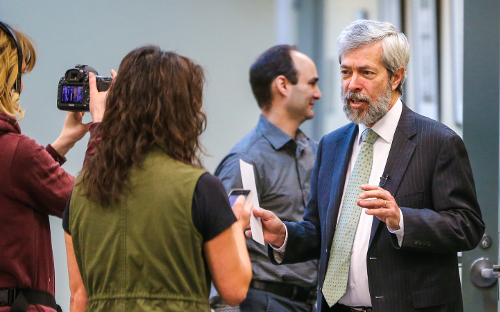 |
"If boards want a long-term president for eight to 10 years, then a sabbatical should be an integral part of that commitment," says Gordon T. Smith (right).
Credit: Sergei Belski |
Smith’s board chair, a layperson in the oil and gas business, agreed to serve as interim president and work half a day, every day. Smith knew that the only way he could be away for so long was to have an acting leader in whom he had complete confidence. And in fact, the acting president did have to initiate a building renovation while he was away. “We both agreed it had to happen, and he took the political hit for me.”
Smith says that if a president is going to take a sabbatical, he or she must have someone trustworthy on whom to rely. “I had two people, my executive assistant and the board chair,” he says. “The executive assistant knew the office, and I knew she would call me if anything needed my immediate attention. Without that kind of backing, I don’t see how it can be done.”
He thinks that written policies about presidential leaves are not necessary. “There’s never an ideal time,” he says. Each president differs, each institution differs, and the best timing and length for a leave varies. “However, if boards want a long-term president for eight to 10 years, then a sabbatical should be an integral part of that commitment,” he says.
Sabbaticals are rare for Catholic rectors
Monsignor Todd Lajiness, rector and president of Sacred Heart Major Seminary in Detroit, is also president of the National Association of Catholic Theological Schools, which includes about 35 accredited institutions.
Lajiness says that rectors of Catholic seminaries don’t typically take sabbaticals while they hold the office. However, after a five- or ten-year stint in academic administration, a bishop may give an outgoing rector a few months of leave before he’s given another assignment — often as the pastor of a parish or as an administrator in the diocese.
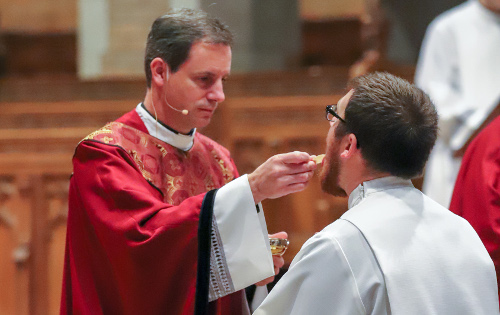 |
Rectors of Catholic seminaries don't typically take sabbaticals while they hold office, says Monsignor Todd Lajiness (left). According to canon law, the rector is the pastor of the seminary community.
Courtesy Sacred Heart Major Seminary |
“The uniqueness of a Catholic seminary is that the priest who serves as rector and president is ‘canonically resident’ and is responsible to the bishop of the local diocese,” Lajiness says. “The local bishop is typically chairman of the board of trustees.”
Monsignor Jeremiah McCarthy, moderator of the curia for the Diocese of Tucson, Arizona, formerly served as rector, vice rector, and academic dean at Saint John’s Seminary in Camarillo, California. In an e-mail message, he wrote: “According to canon law, the seminary rector is also recognized as the ‘pastor’ of the seminary community. This pastoral role as spiritual leader of the seminary community requires presence on the campus and is a significant factor that gravitates against his absence for an extended period.”
McCarthy adds that at Saint John’s, he never took a sabbatical during his 18 years in academic administration. But when he left the seminary in 2001 to take a position at the Association of Theological Schools, his bishop granted him six months of leave before he started his new job.
Those who’ve taken sabbaticals recommend them
Personnel issues, financial reports, updates on facilities and capital projects, letters of recommendation — all pass across a president’s desk every day. The pace is demanding, and creating the time and finding others to take up the slack is not easy.
For presidents who want to take a sabbatical, David Williams at Taylor Seminary says “just do it, whatever it takes.” He adds that the president must create a system that makes it possible to be away. “You’ve got to create a system that allows you to take some time off.”
An informal poll of seminary presidents on sabbaticals
Earlier this year, In Trust surveyed 566 current and former seminary presidents to ask whether they had taken a sabbatical. Ninety-two seminary presidents and chief executives responded, for a response rate of 16.25 percent. Of those, 24 percent reported having taken a sabbatical. Among those who had taken one, their length of service as a chief executive before the sabbatical ranged from three to 13 years, with an average length of service of 7.1 years. The length of their sabbaticals ranged from a day per month to a full academic year.
The survey asked: “What was the purpose of your sabbatical?” About a third described the purpose as “research,” a third said “rest and renewal,” and a third said “both.”
The survey also asked: “If you’ve never taken a sabbatical as chief executive, why not?” Their answers are shown below. “Too soon” means that the president has not been in the office long enough for a sabbatical. “No policy” means that the board of trustees does not have a policy or provision for presidential sabbaticals. “No time” means that it has been too difficult to find time for one or a suitable interim replacement. “At retirement” means that the president hopes to take a sabbatical with full pay at the end of service as president.
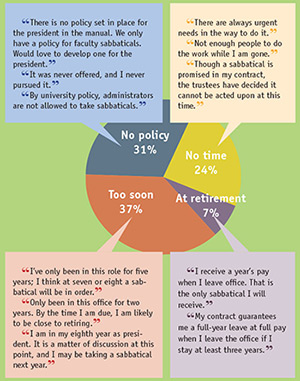 |
| Click image to enlarge. |